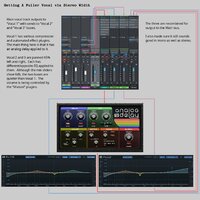Wow, there's just a ton of useful info in this thread! Thank you!
It looks like this is one of those times where a term is used to mean multiple things. "Fattening" is apparently used both for 1) sort of the density of sound information, to paraphrase what
@parallax_fifths and
@Buck were describing, and 2) the stereo placement/delay technique
@IO+ was discussing that results in a "bigger" sound.
I had encountered the latter of these in
"The Art of Mixing," but reading through the thread, I realized that I'd forgotten about the delay component. I think that was the reason I was confused about how stereo imaging (which I was thinking of mostly in the context of stereo width) was different. Since the stereo/delay trick is basically putting a ~30ms delay on a mono signal and panning the original signal and the delay copy of that signal to the L/R, respectively, if you remove the delay part of this technique, you end up with just stereo placement considerations. :)
If you're interested,
GSatPlus from TBProAudio is free and supports up to 4x oversampling. (Oversampling, in my opinion, is a must for non-linear plugins, such as saturation, distortion, and compression.)
Definitely interested! I've had some positive results putting saturation on my vocals, so I'll check this out!
I think, fattening term is refer to very small delay between each channel (might have other modulation involved), that give you an illusion to perceive the sound "fatt" some people call "thick", even they're the same amplitude, it might even make you feel louder.
Let say L channel space out from R channel by 12 millisecond and R channel space out from L channel by 20 millisecond (may have a slightly detune). A few milliseconds, aren't perceived as echoes or flams, but as changing the apparent position of the source signal, but we have plugins that can do such thing call Doubler. A very tight delay can make anything sound dense.
Also a traditional delay or manually adjusting time of your source can get the job done too.
You might try to add some modulation thing like detune, with small amount of distortion or saturation can make a big different.
I think that's why analog echo tape like echoplex ep3 is so popular due to how wonky of their sound.
____________
Stereo imaging: tl;dr: Stereo Imaging is the manipulation of a signal within a 180-degree stereo field.
I wish i have time to make a picture.
A Stereo Image can be broken down into 3 distinct sections:
The center 90 Degree image
The Left 45 Degree Image
The Right 45 Degree Image
The majority of your signal will be located within the first section – that is the center 90-degree image.
A traditional pan pot that you use will operate within this 90-degree image, say if you were to pan a guitar hard left, it would be to the full left side of this 90-degree stereo image.
In order to access to the 2nd and 3rd sections of a 180-degree stereo image, this is where delay and phase cancellation comes into play. By separating a mono signal into two separate signals, and then delaying one slightly (or significantly), you cause phase cancellation and in turn, widen the stereo image.
This phase cancellation results in the widening of the signal into various parts of the full 180-degree stereo image. The degree to which the signal is widened depends on multiple variables, including the frequency and amplitude of the signal, and the amount of delay used.
I'm a little confused. These two items (below/above the line) seem like they're similar to me. Wouldn't the technique above the line would have the same mono phase cancellation behavior as seen in the technique below the line? So are these two different ways of describing the same thing, or is there a difference between the two that I'm not understanding? Not that there's any issue either way; I'd just like to maximize what I'm learning :) .
Stereo width is more to do with the difference between the left and right stereo channels as the two above me have pointed out. A stereo imaging plugin will do this, but this actually comes at the expense of perceived loudness most of the time. Most people would rather layer, double-track or use methods like the unison that synthesizers sometimes have to achieve sounds that are wider.
That's good to know. Definitely true; you can hear how widening makes the sound airier/less dense and quieter, so considering those other options as alternatives will be really helpful. Then again, if I'm
looking for an airier sound, taking the opposite approach is something to keep in mind.... Thank you!
All the discussion about the amount of mono/stereo in low/high-pitched frequencies will be very helpful, too!
Thanks very much to everyone for all of the useful discussion!









